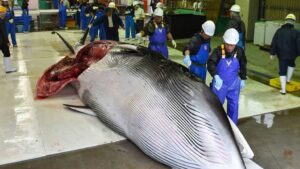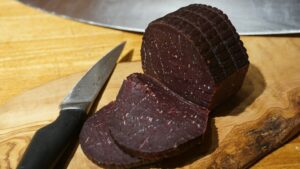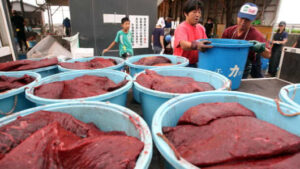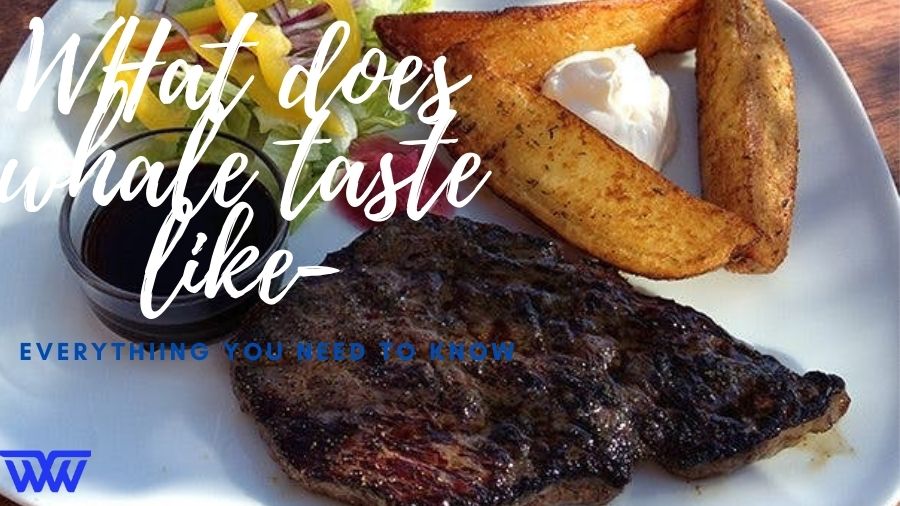What does a whale taste like?
It is similar to moose or reindeer. Whale tastes much more like its hairy cousins on land than its grilled neighbor in the sea. In places where gamey meats are common- like Norway, Iceland, and among the indigenous people of Alaska– the whale is served straight up with little or no seasoning.
A Santa Monica, Calif, sushi restaurant has been charged with endangered whale meat to its customers. Two activists initiated the investigation by ordering Kujira, Japanese for whale meat, then stuffing some into napkins for transport to an Oregon laboratory. (The restaurant obligingly listed the order as “whale” on their receipt)

What does a whale taste like?
A whale is served straight and with no seasoning. For those who find its unrefined flavor off-putting, a whale is cured, marinated, or slathered with a flavorful sauce. Whale bacon, marketed in shrink-wrapped packages of thin marble slices closely resembling pork bacon, is offered at some Japanese markets. Whale meat carriers are sold from a few Tokyo lunch trucks. Japanese schools are currently trying to figure out a way to get children to eat meat at lunch, possibly turning to whale burgers or fish street-style preparations. But some Japanese traditionalists still enjoy gamey.
Japanese whale meat restaurants which are rare and do not flaunt their presence to westerners also serve cubed and grilled blubber, cartilage salads, and whale skin stew. In times gone by, Japanese global men consumed whale gums too and served the trachea and duodenum to the poor. The practice of spreading the whale out among many people is based on the Buddhist principle that it is better to sacrifice a single soul to feed many than to kill many animals to feed one person. Thus many schools of Buddhism favor eating whales and recommend against eating shrimp.

The amount of whales that are eaten in Japan has fluctuated over the year. A staple in some communities in previous centuries the meat fell out of favor in the early 20th century. Following world war II, when the country’s infrastructure was badly damaged. Whale meat made a comeback, providing nearly half o with the country’s protein by some account. In recent years, it has fallen again. While the United States is now a strong opponent of whales during times of shortage. Federal authorities held a luncheon (PDF) at the American Museum of Natural History in 1918, trying to push whales as a home front substitute for the beef that our troops craved.
Nutritionally whale meat is a bit of a mixed bag. Both the tail and belly meat are lower in fat and calories and higher in protein than most cuts of pork and beef (although chicken breasts and fish beat the mammals in all three categories) whale is comparable to fish in omega-3 content. Studies however have shown whale meat also carries dangerously high levels of mercury and PCB.
Does the whale taste fishy?
Because it is a mammal, whale meat is not like fish, but a more very gamey version of beef, or even venison. The taste is different from beef. Red whale meat has more protein than beef, is a good source of iron, and is rich in niacin.
Is whale meat expensive?
The fresh meat sold for up to 15,000 yen per kilogram, several times higher than the prices paid for Antarctic minkes, at a wholesale market in Sendai, one of several cities on Japan’s northern coasts to hold the auction. The meat came from two minkes caught by a fleet of five catcher boats off the northern city of Kushiro on Monday when Japan resumed commercial whaling after 31 years, During those years it conducted research hunts in the Antarctic and the northwestern Pacific that conservations criticized as a cover for banned commercial hunts.
Japan left the international whaling commercial on June 30 and has promised the whalers will stay within its 200-mile exclusive economic zone waters. The fishers agency set the catch quota through the end of the year at 227 whales-fewer than the 627 Japan had hunted in those distant waters for its research program in recent years.
At Thursday’s auction, the high-priced fatty belly meat called” unusual” was part of the 120 kilograms (264 pounds) purchased by Sendai Suisan Co., the company said. It also put in 10,000 yen per kilogram for red meat. The prices were much higher than the average 2,000 yen per kilogram.
Separately, 66kilograms (145 pounds) of whale meat was auctioned in Taiji, one of the traditional whaling towns also known for its dolphin hunts that were shown in the Documentary Film “The Cove.”
Meat from whales hunted by the other fleet in the Antarctic will be frozen and distributed separately. Whale meat sellers are also worried about the slim demand. Whale meat was an affordable source of protein during the lean times after world war II, with annual consumption peaking at 223,000tons in 1962, but the whale was quickly replaced by other meats. Today annual supply is down to about 4,000-5,000 tons, According to the fisheries Agency.
Can you eat whale skin-
The skin and blubber, known as Muktuk, Taken from the bowhead, beluga, or narwhal is also valued and is eaten raw or cooked. There is relatively little demand for it, compared to farm livestock and commercial whaling, which has faced opposition for decades, continuous today in very few countries (mainly Iceland, Japan, and Norway), although whale meat used to be eaten across western Europe and colonial America.
However, wherever dolphin, drive hunting, and aboriginal whaling exist, marine mammals are eaten locally as part of the subsistence economy. In the Faroe Islands, in the circumpolar Arctic the Inuit in Canada and Greenland, related peoples in Alaska, the Chukchi peoples of the United States (including the Makah people of the Pacific Northwest), in St. Vincent and the grenadines (mainly on the island of Bequia), in a couple of villages in Indonesia and in certain south Pacific islands.

Is it safe to eat whale meat?
Some of it is dolphin, porpoise, or beaked whale meat. People who eat Kujira, thinking that they are avoiding unsafe levels of contaminants, may in fact be eating meat that contains very high levels of toxic substances. Regardless of the amount, the consumption of whale meat can expose humans to dangerous contaminants.
Whale meat or blubber is consumed in Norway, Japan, some Caribbean nations, Russia, Canada, and the states of Alaska either for subsistence, cultural or commercial reasons.
In Japanese markets, generic whale meat or ‘Kujira‘ is said to come from the minke whales killed as a part of the so-called scientific whaling program. People who eat Kujira, thinking they are avoiding unsafe levels of contaminants, may in fact be eating meat that contains very high levels of toxicity.
PCBs can cause nerve damage, reproductive and developmental disorders, immune system suppression, liver damage, skin irritation, and endocrine disruption. DDT exposure is associated with certain cancer risks and neurological and reproductive disorders. Dioxins can cause cancer, metabolic dysfunction, and immune system disorders. Methylmercury consumption can cause neurological and developmental problems. The contaminants are often highly concentrated in blubber because they are lipophilic, meaning they bond easily and even preferentially to fat.
Whales no longer live in a pristine environment. We have polluted their habitat with poisons that concentrate in their tissues. Regardless of the amount, the consumption of whale meat can expose humans to dangerous contaminants.
What if we never hunted whales?
If the whale hunt never happened, there would be less carbon in our atmosphere, and our planet would be a lot healthier. If we restored whale populations to pre-hunt levels, we could remove about 160,000 tons of carbon from our atmosphere every year. That is equivalent to adding 843 hectares of forest. But how can one species be so important to the entire planet? Looking back, it’s clear why whale hunting was such an enticing business opportunity. Their meat could be used to feed the masses, their oil could be lubricated machinery and light up a room, their intestines could produce perfume, and their cartilage was so perfect for holding together products like corsets and umbrellas.
Why does Japan kill whales?
Since 1987, Japan has killed between 200 and 1,200 whales each year, saying this was to monitor stocks to establish sustainable quotas. Critics say this was just a cover so Japan could hunt whales for food, as the meat from the whales killed for research usually did end up for sale..
There is a long history of anti-whaling in Japan. Whales were brought to the brink of extinction by hunting in the 19th century. By the 1960s, more efficient catch methods and giant factory ships made it obvious that whale hunting could not go unchecked..
so in 1986, all IWC members agreed to a hunting moratorium to allow whale numbers to recover. Conservationists were happy but whaling countries like Japan, Norway, and Iceland assume the moratorium would be temporary until everyone could agree on sustainable quotas. Instead, it became a Quasi- permanent ban.
But there were exceptions in the moratorium, allowing indigenous groups to carry out subsistence whaling, and allowing whaling for scientific purposes.
Why is Japan restarting whaling now?
In 2018 Japan tried one last time to convince the IWC to allow whaling under sustainable quotas. but failed. so I left the body, effectively in July 2019.
- Could the ban on killing whales end?
- Pro-whaling nations block sanctuary plan,
Whaling is a small industry in Japan, employing around 300 people. About five vessels are expected to set sail in July.
The whaling “will be conducted within japan’s territorial waters and Exclusive Economic Zone”, Hideli moronuki of the Japanese fishing ministry told the BBC in June.
This means Japan will no longer hunt whales in the Antarctic, as it did under its earlier research program. The catch cap of 52 minke whales, 150 Bryde’s whales, and 25 sei whales is also lower than the 333 cap set for last year’s research hunt. Like other whaling nations, Japan argues hunting and eating whales are part of its culture. A number of coastal communities in Japan have indeed hunted whales for centuries but consumption only became widespread after world war Two when other food was scarce.
From late 1940 to the mid-1960 whale was the single biggest source of meat in Japan but has since become a niche product again.
What Environmental impact will Japan’s whaling have?
The ministry will allow for the hunting of three species, Minke, Bryde’s, and sei whales. According to the IUCN Red List of threatened species, minke and Bryde’s whales are not endangered. Sei whales are classified as endangered but their numbers are increasing. So in terms of numbers, Japan’s commercial whaling will have only a minimal impact.
In fact, some defenders of whaling argue that whale meat has a smaller carbon footprint than pork or beef. Conservationist groups like Greenpeace or sea shepherd remain critical of Japan’s resumption of whaling but say there are no concrete plans yet to tackle the country over this.
Japanese out of step with the international community”, Sam Annesley, executive director at Greenpeace Japan, said in a statement, urging Tokyo to abandon its hunting plans. Besides the question of stock sustainability, a key argument against the hunt is that harpooning whales leads to a slow and painful death.
Conclusion
We have known about steak meat made of beef and other cattle meat. But have you heard of whale steak? Whale meat is not common meat you can find in the store, so if you wonder,” what does whale taste like?” or “is whale meat good? The whale is the biggest mammal on our planet, representing the diversity of mother nature with its enormous size. Whales are also considered rare meat like porcupines in some countries. In the US, it is illegal to sell whale meat. so, do people eat whales. Whale meat is restricted due to two reasons whale meat toxicity and population control.
Enter your email to stay updated with offers
If you can’t see the form above, click here to open the form.







Add Comment